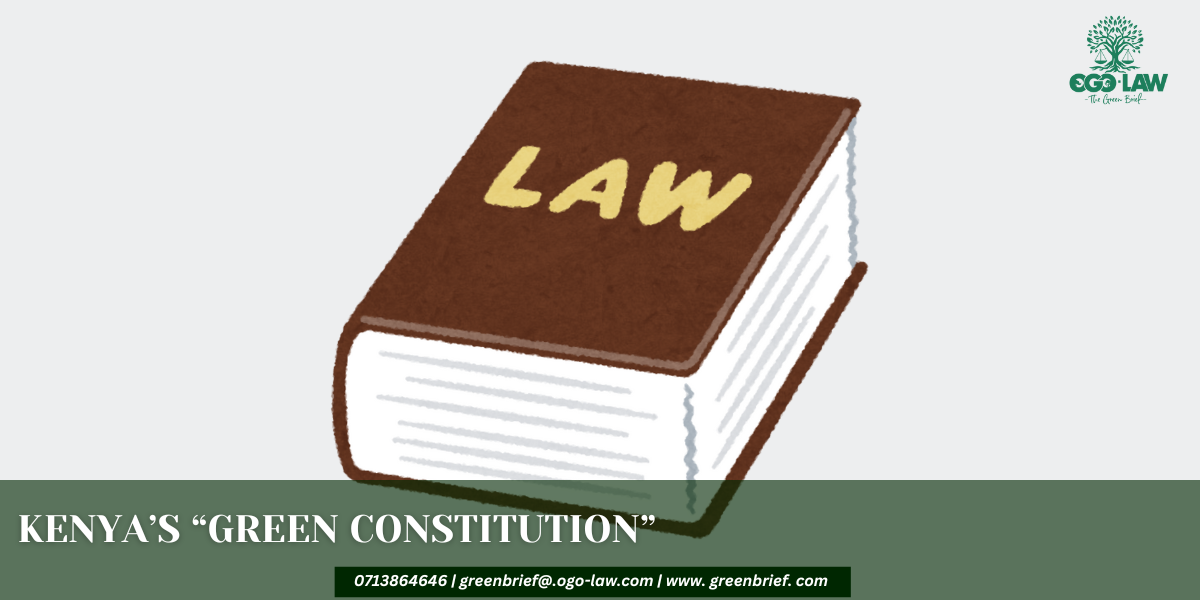The Legal Clauses That Give Environmental Protection its Teeth
The legal fight for environmental protection in Kenya is fundamentally different from many other jurisdictions because of one document: the Constitution of Kenya, 2010. This framework has rightfully earned the moniker of a “Green Constitution” for transforming environmental stewardship from a policy goal into a fundamental human right. For lawyers, activists, and concerned citizens across Africa, this is a supremely powerful tool.So, what makes the Kenyan Constitution so potent for environmental protection? The power is primarily housed in a triad of key articles that establish rights, impose duties, and provide clear enforcement mechanisms.
The Foundation: A Fundamental Human Right (Article 42)
The most revolutionary clause is Article 42, nestled within the Bill of Rights. It unequivocally states: “Every person has the right to a clean and healthy environment.”
This is not a mere aspiration; it is a justiciable, enforceable right. By elevating a clean and healthy environment to the same level as the right to life or freedom of expression, the Constitution provides a direct legal avenue for redress against pollution and degradation. Critically, Article 42 includes the right to have the environment protected for the benefit of present and future generations, embedding the principle of inter-generational equity right at the heart of Kenyan law. This constitutional grounding makes environmental violations human rights violations, significantly raising the stakes in court.
The Obligation: Duties on the State and Citizens (Article 69)
A right without a corresponding duty is often toothless. That’s where Article 69 steps in, establishing explicit, non-negotiable obligations on the State. The State is not merely encouraged, but is mandated to:
- Ensure sustainable exploitation and management of natural resources and equitable sharing of the accruing benefits. This is the constitutional mandate for sustainable development, ensuring that economic activity does not compromise environmental integrity for profit alone.
- Establish systems of Environmental Impact Assessment (EIA), audit, and monitoring. This provision makes pre-emptive legal tools like mandatory EIAs for large development projects a constitutional requirement. A failure to conduct a thorough EIA is not just an administrative error; it’s a constitutional breach.
- Work to achieve and maintain a tree cover of at least ten per cent of the land area of Kenya. This is a quantifiable, measurable constitutional target that can be enforced in court. This provision provided a significant legal basis for the government’s efforts to reclaim and restore crucial water tower areas like the Mau Forest complex, demonstrating the Constitution’s direct influence on national conservation policy.
Crucially, Article 69 (2) places a reciprocal duty on every person to cooperate with the State to protect and conserve the environment. Environmental protection is, therefore, a shared national responsibility, not just a government problem.
The Enforcement: Liberalized Locus Standi (Article 70)
The pièce de résistance for environmental lawyers is Article 70, which provides the ultimate power of enforcement. This clause grants liberalized locus standi, meaning a person can approach the court without having to prove they have suffered personal loss or injury.
- You don’t have to be a victim to seek justice. Any person can apply to a court if they allege that a right to a clean and healthy environment has been, is being, or is likely to be violated. This revolutionary clause allows for public interest litigation, enabling environmental activists and communities to fight for the collective good.
This provision was instrumental in the landmark Uhuru-Owino case in Mombasa, where residents suffered from lead poisoning. The Supreme Court upheld the constitutional right to a clean environment, holding both state agencies (like NEMA) and private companies accountable and ordering significant compensation and environmental restoration. The ruling is a powerful precedent, illustrating the judiciary’s role as the final guardian of Kenya’s ‘Green Constitution’ and reinforcing principles like the Polluter Pays principle.
The Kenyan Constitution has set a remarkably high bar for environmental governance, not just for Kenya, but as a blueprint for constitutional reform across Africa. For a new generation of environmental advocates and lawyers, the articles of this Constitution are the most powerful tools in your arsenal.
Are you witnessing a project that bypasses an EIA? Is a local factory polluting your community’s water source? The law is on your side. We urge you to familiarize yourself with Articles 42, 69, and 70. These are the clauses that empower you to move beyond mere advocacy and demand constitutional compliance. Don’t just talk about environmental justice, use the ‘Green Constitution’ to enforce it





